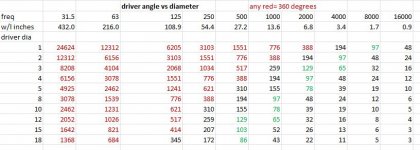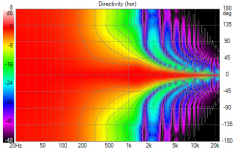I have a dream of making two custom consoles/cabinets with matching speakers, and the speakers looking different by having only a horn visible. Ideally this would mean having woofer(s) on the back* or 2nd best the sides, some of which would be slot loaded (Left - cabinet - Center - cabinet - Right with at most a couple inches in between. TV sitting on top.
This raises the question:Up to what frequency are woofers really pretty omnidirectional?
(0) Can anyone point to DATA of woofers measured at 90 degrees or even better behind the cabinet?
(1) Hmm, I can calculate theoretically that at 90 degrees from forwards, if we say 90 degree phase shift for -3 dB cancellation IIRC, that is 1/4 wavelength. So let's pretend a 12" woofer is actually a 12" piston. That means 1/4 wave = 1 foot, so wavelength λ = 4 feet.
v = f * λ
1100 ft/s = f * 4
f = 1100/4 = 275 Hz.
Does that seem correct?
(2) At higher frequencies, effective piston area can narrow. Is this a factor at frequencies before the speaker becomes directional? I'm thinking not...
(3) If we put say two 6" next to each other, I'd expect the same result as above, again ignoring that the piston diameter is not really the same as the woofer size. BUT what if we put two 6" next to each other facing the wall? And what if, further, you put a physical divider between the speaker and the wall? On the one hand, it seems that should keep the wave from one 6" from interfering with the one next to it, meaning each 6" only cancels its own wave. On the other hand, that seems like a free lunch.
*https://www.diyaudio.com/forums/multi-way/357957-backwards-facing-loudspeaker-project.html
Probably dreaming the impossible dream, I'm rather doubting I can get a horn to go low enough without (a) becoming too wide for the space available and (b) able to cover up to the top treble even using EQ.
This raises the question:Up to what frequency are woofers really pretty omnidirectional?
(0) Can anyone point to DATA of woofers measured at 90 degrees or even better behind the cabinet?
(1) Hmm, I can calculate theoretically that at 90 degrees from forwards, if we say 90 degree phase shift for -3 dB cancellation IIRC, that is 1/4 wavelength. So let's pretend a 12" woofer is actually a 12" piston. That means 1/4 wave = 1 foot, so wavelength λ = 4 feet.
v = f * λ
1100 ft/s = f * 4
f = 1100/4 = 275 Hz.
Does that seem correct?
(2) At higher frequencies, effective piston area can narrow. Is this a factor at frequencies before the speaker becomes directional? I'm thinking not...
(3) If we put say two 6" next to each other, I'd expect the same result as above, again ignoring that the piston diameter is not really the same as the woofer size. BUT what if we put two 6" next to each other facing the wall? And what if, further, you put a physical divider between the speaker and the wall? On the one hand, it seems that should keep the wave from one 6" from interfering with the one next to it, meaning each 6" only cancels its own wave. On the other hand, that seems like a free lunch.
*https://www.diyaudio.com/forums/multi-way/357957-backwards-facing-loudspeaker-project.html
Probably dreaming the impossible dream, I'm rather doubting I can get a horn to go low enough without (a) becoming too wide for the space available and (b) able to cover up to the top treble even using EQ.
Here's a rule of thumb i pulled from a Stereophile interview with John Dunlavy.
His quote:
" A 4" midrange will have a very broad beam; the 15" woofer will have a very narrow beamwidth—you can find it by dividing 57 by the dimension expressed in wavelengths. That's the beamwidth."
If i didn't screw up, the chart below takes that formula to driver diameter.
All red values are 360 deg.
The green values are me tagging where 90 degree coverage was close....
Black are the narrow/beaming values.
His quote:
" A 4" midrange will have a very broad beam; the 15" woofer will have a very narrow beamwidth—you can find it by dividing 57 by the dimension expressed in wavelengths. That's the beamwidth."
If i didn't screw up, the chart below takes that formula to driver diameter.
All red values are 360 deg.
The green values are me tagging where 90 degree coverage was close....
Black are the narrow/beaming values.
Attachments
You are conflating 90 degrees in time, with 90 degrees off-axis.that at 90 degrees from forwards, if we say 90 degree phase shift for -3 dB cancellation IIRC, that is 1/4 wavelength. So let's pretend a 12" woofer is actually a 12" piston. That means 1/4 wave = 1 foot, so wavelength λ = 4 feet.
So it is, my bad.
Rule of thumb suggests that a 12" driver should be around 90 degrees (+/-45) at 1300Hz so 275 is a ways off.
If calculating it should be remembered that cancellation nulls don't normally have a virtual source within the plane of the piston.
If measuring it should be remembered that this is going into lobing territory and a higher resolution might be needed to prevent glaring errors.
Rule of thumb suggests that a 12" driver should be around 90 degrees (+/-45) at 1300Hz so 275 is a ways off.
If calculating it should be remembered that cancellation nulls don't normally have a virtual source within the plane of the piston.
If measuring it should be remembered that this is going into lobing territory and a higher resolution might be needed to prevent glaring errors.
Theories and calculations get tricky when a driver is in some sort of baffle and perhaps a box - or a slot! You must make a proto and measure it!
Some measuements 3D3A Lab at Princeton University
Pro audio folks talk a lot about -6dB dispersion angles, but that is not the whole story!
Loudspeaker Facts - Directivity as a Design Issue
Some measuements 3D3A Lab at Princeton University
Pro audio folks talk a lot about -6dB dispersion angles, but that is not the whole story!
Loudspeaker Facts - Directivity as a Design Issue
Ground plane measurement suits for any radiator type but requires lots of space. Diffraction simulator is another option to estimate effect of baffle size because cone alone does not define directivity to full space.
This is closed 12" in 340x340 mm baffle simulated to 10 meters with Diffraction tool of VituixCAD. Not exactly accurate for sure but gives some clue about omni limit. 1st contour is -3 dB.
This is closed 12" in 340x340 mm baffle simulated to 10 meters with Diffraction tool of VituixCAD. Not exactly accurate for sure but gives some clue about omni limit. 1st contour is -3 dB.
Attachments
Theories and calculations get tricky when a driver is in some sort of baffle and perhaps a box - or a slot! You must make a proto and measure it!
Where's the pontificating fun in that?
This raises the question:Up to what frequency are woofers really pretty omnidirectional?
The picture below is from Altec's technical paper

P.S.
You can also evaluate the upper limit of "the beaming frequency" yourself: any woofer become directional when its perimeter become larger than the wavelength. This statement is equivalent to the mathematical expression k*a=1, where k=2πf/c is the wavenumber and a is piston radius. So the upper limit for "beaming frequency" is f= c/(2πa). If we take c=344m/s and 2π=6.28, then we get a simple expression convenient for practical uses f=54.78/a, where the radius a should be expressed in meters. For example for 15" having a=0.16 m f is about 342Hz (the radiated acoustic power decreases above this frequency while the radiation pattern become narrower (the narrowing rate of DI index of a flat piston in infinite baffle is 6dB/oct)).
Note, that this is only the upper limit for "the beaming frequency", while the baffle shifts the frequency to the lower frequencies side.
Last edited:
- Home
- Loudspeakers
- Multi-Way
- So, up to what frequency are drivers REALLY omnidirectional?

